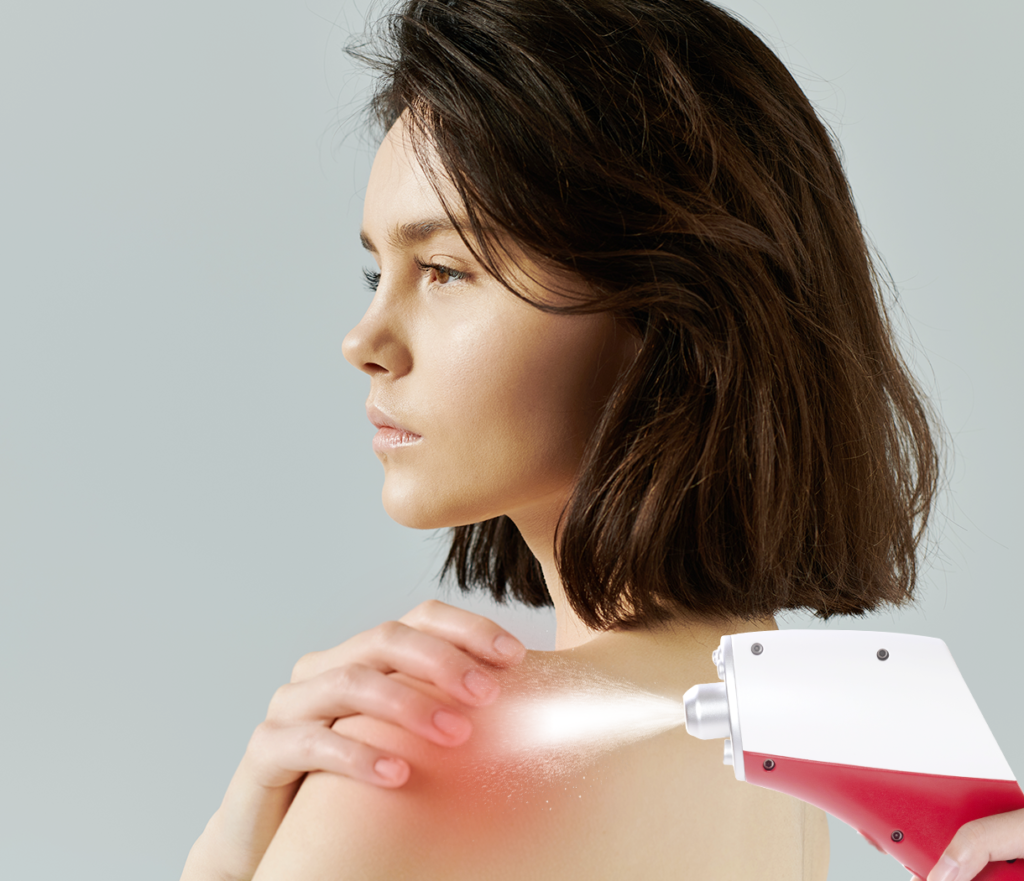Introduction: The Science of Healing Through Cold
The therapeutic application of cold has evolved dramatically from simple ice pack applications to sophisticated cryotherapy modalities that harness precise temperature control for optimal healing. Among these innovations, CO₂ cryotherapy stands out as a scientifically advanced approach that leverages extreme cold to activate the body’s innate regenerative mechanisms. This treatment modality combines the principles of thermal physiology with targeted application techniques to achieve rapid therapeutic outcomes across diverse clinical scenarios.
¿Qué es la crioterapia de CO₂?
La crioterapia de CO₂ utiliza dióxido de carbono presurizado gas delivered at temperatures reaching -78°C to induce localized thermal shock in targeted tissues. This controlled application of extreme cold creates rapid vasoconstriction followed by reactive hyperemia, stimulating cellular repair mechanisms. The treatment employs specialized applicators that direct the supercooled CO₂ gas precisely to affected areas, typically for durations of 10-15 seconds per site. Unlike whole-body cryotherapy chambers, this localized approach concentrates therapeutic effects exactly where needed, maximizing benefit while minimizing systemic exposure.
Why People Turn to CO₂ Cryotherapy for Recovery and Regeneration
Patients increasingly seek CO₂ cryotherapy due to its non-invasive nature and immediate symptomatic relief compared to pharmaceutical interventions or surgical options. Athletes utilize this modality to accelerate recovery between training sessions and competitions, reducing downtime from musculoskeletal injuries. Individuals with chronic pain conditions find value in its drug-free approach, avoiding potential medication side effects and dependency concerns. The treatment’s rapid action—providing noticeable relief within seconds—appeals to those requiring quick intervention. Additionally, minimal contraindications and excellent safety profiles make it accessible to diverse patient populations.
The Concept of Natural Regeneration
Natural regeneration refers to the body’s inherent capacity to repair damaged tissues through coordinated cellular and molecular processes. These mechanisms include inflammatory responses that clear debris, angiogenesis establishing nutrient supply, and cellular proliferation replacing damaged structures. CO₂ cryotherapy amplifies these processes by creating controlled stress that upregulates regenerative pathways without causing additional tissue damage. The thermal stimulus activates heat shock proteins, stimulates growth factor release, and enhances mitochondrial function. This approach works synergistically with endogenous healing mechanisms rather than suppressing symptoms artificially.
Understanding the Healing Challenge
Effective tissue repair requires coordinated biological responses that sometimes become dysregulated or insufficient following injury or disease. When these natural healing processes fail to progress normally, patients experience prolonged symptoms, functional limitations, and reduced quality of life. Understanding these challenges provides essential context for appreciating how CO₂ cryotherapy addresses fundamental barriers to optimal recovery.
How Tissue Damage and Inflammation Interfere with Recovery
Acute inflammation, while necessary for initiating repair, can become excessive or prolonged, creating secondary tissue damage through oxidative stress and proteolytic enzyme activity. Edema accumulation increases interstitial pressure, compromising microcirculation and causing hypoxia that impairs cellular metabolism. Pro-inflammatory cytokines like interleukin-1 and tumor necrosis factor-alpha perpetuate inflammatory cascades beyond their beneficial acute phase. Pain resulting from inflammatory mediator effects on nociceptors creates protective muscle guarding that further restricts movement and blood flow. This vicious cycle of inflammation, pain, and immobility significantly delays restoration of normal tissue function.
Why Traditional Recovery Methods Sometimes Fall Short
- RICE offers limited depth and inconsistent results.
- Painkillers mask symptoms but don’t promote healing.
- Physical therapy requires long-term compliance and may be painful early on.
- Corticosteroids reduce inflammation temporarily but can weaken tissue.
- Conventional methods often treat symptoms, not tissue regeneration.
Common Conditions CO₂ Cryotherapy Can Help
- Acute sports injuries heal faster with reduced hematoma and secondary damage.
- Chronic tendinopathies benefit from anti-inflammatory and analgesic effects.
- Post-surgical edema and pain respond well to localized cooling.
- Osteoarthritis sees relief through reduced inflammation and improved mobility.
- Muscle spasms and trigger points relax with thermal shock.
- Inflammatory skin conditions and minor burns improve with targeted CO₂ therapy.
La ciencia detrás de la crioterapia de CO₂
The therapeutic mechanisms of CO₂ cryotherapy stem from fundamental principles of thermal physiology and cellular biology. By delivering precisely controlled cold exposure, this treatment initiates cascading biological responses that extend far beyond simple symptom management. Understanding these mechanisms reveals why CO₂ cryotherapy achieves outcomes that traditional cooling methods cannot replicate, establishing it as a distinct therapeutic modality rather than merely an enhanced ice pack.
How CO₂ Cooling Stimulates Cellular Regeneration
Rapid temperature reduction triggers expression of cold shock proteins and heat shock proteins that protect cellular integrity during thermal stress. This molecular response upregulates genes involved in cellular repair, including those encoding growth factors like fibroblast growth factor and insulin-like growth factor. Mitochondrial biogenesis increases, enhancing cellular energy production capacity necessary for repair processes. The thermal stimulus activates AMP-activated protein kinase pathways, improving glucose uptake and metabolic efficiency. Simultaneously, autophagy mechanisms are enhanced, clearing damaged cellular components and facilitating renewal. These coordinated responses create optimal intracellular conditions for regeneration.
Thermal Shock: Triggering Regenerative Cellular Pathways
The extreme temperature differential between -78°C CO₂ gas and normal tissue temperature creates acute thermal shock that activates mechanosensitive and thermosensitive cellular receptors. This activation initiates signal transduction cascades involving MAP kinase and PI3K/Akt pathways, promoting cell survival and proliferation. Reactive oxygen species generation at controlled levels functions as signaling molecules rather than damaging oxidants, stimulating antioxidant defense systems. The stress response mobilizes stem cells from adjacent tissues and enhances their differentiation potential. Additionally, thermal shock modulates gene expression patterns, shifting cells toward regenerative phenotypes and away from inflammatory or apoptotic states.
Key Biological Benefits of CO₂ Cryotherapy
- Vasoconstriction reduces bleeding, limits swelling, and preserves cell viability.
- Rewarming-induced vasodilation improves oxygen, nutrient delivery, and waste removal.
- Cold blocks pain signals, providing immediate analgesia.
- Muscle spindle activity decreases, reducing spasms and improving mobility.
- Anti-inflammatory effects lower enzymatic activity and prostaglandin production.
- Supports long-term tissue remodeling and stronger, healthier tissue.
CO₂ Cryotherapy in Regeneration and Recovery
Clinical application of CO₂ cryotherapy addresses multiple aspects of tissue healing simultaneously, providing comprehensive therapeutic benefits that accelerate recovery timelines. By targeting inflammation, pain, tissue regeneration, and circulatory function concurrently, this modality creates optimal conditions for restoration of normal tissue architecture and function. Growing clinical evidence supports its integration into standard treatment protocols across various medical specialties.
Reducing Inflammation and Swelling for Faster Healing
CO₂ cryotherapy induces immediate vasoconstriction that limits extravasation of plasma proteins and inflammatory cells into injured tissues, preventing excessive edema accumulation. The cold temperature directly reduces cellular metabolic rate and enzymatic activity, decreasing production of inflammatory mediators including prostaglandins, leukotrienes, and bradykinin. Lymphatic drainage improves following treatment, facilitating removal of accumulated fluid and inflammatory byproducts. By controlling the inflammatory response magnitude, cryotherapy prevents secondary tissue damage while preserving beneficial aspects of acute inflammation. This balanced inflammatory modulation significantly shortens recovery timelines compared to uncontrolled inflammation scenarios.
Stimulating Tissue Regeneration and Collagen Production
Thermal stress from cryotherapy activates fibroblasts and stimulates collagen synthesis, essential for restoring tensile strength to damaged connective tissues. The treatment enhances transforming growth factor-beta signaling, a key regulator of extracellular matrix production and tissue remodeling. Angiogenic factors including vascular endothelial growth factor increase following cryotherapy, promoting neovascularization in healing tissues. Improved microcirculation delivers progenitor cells and growth factors to injury sites. Collagen cross-linking enzymes are upregulated, ensuring newly synthesized collagen achieves proper structural organization. This comprehensive stimulation of regenerative processes produces higher-quality tissue repair compared to spontaneous healing.
Pain Relief Through Neurovascular Modulation
Extreme cold dramatically slows nerve conduction velocity, with A-delta and C-fiber nociceptive signals particularly affected, providing immediate analgesic effects. Gate control theory mechanisms are activated as cold sensation preferentially stimulates large-diameter afferent fibers, inhibiting pain signal transmission at spinal cord level. Reduction in tissue edema decreases mechanical pressure on nociceptors embedded within tissues. Muscle spasm reduction eliminates pain caused by sustained muscular contraction and ischemia. Endogenous opioid release increases following cryotherapy application, providing additional pain modulation. These multiple mechanisms create profound analgesia that facilitates therapeutic exercise and functional rehabilitation activities.
Improving Circulation and Oxygenation for Long-Term Health
The biphasic vascular response—initial vasoconstriction followed by reactive hyperemia—produces a circulatory “flushing” effect that enhances tissue perfusion. This improved blood flow delivers increased oxygen and nutrients essential for cellular metabolism and tissue repair. Endothelial function improves through shear stress-induced nitric oxide production, promoting vasodilation and reducing thrombotic risk. Enhanced circulation facilitates removal of metabolic waste products including lactate and carbon dioxide that accumulate in damaged tissues. Long-term repeated treatments may improve baseline vascular reactivity and microvascular density. These circulatory benefits extend beyond immediate treatment effects, supporting sustained tissue health.
Clinical Research and Evidence-Based Outcomes
Controlled trials demonstrate significant pain reduction and functional improvement in acute ankle sprains treated with cryotherapy compared to standard care protocols. Research on delayed-onset muscle soreness shows accelerated recovery and reduced inflammation markers following post-exercise cryotherapy application. Studies in post-operative orthopedic patients reveal decreased analgesic requirements and earlier mobilization with adjunctive cryotherapy. Meta-analyses confirm cryotherapy effectiveness for reducing swelling and pain across various musculoskeletal conditions. Emerging evidence supports applications in wound healing, burn management, and chronic pain syndromes. These findings establish CO₂ cryotherapy as an evidence-based intervention with measurable clinical benefits.

From the User’s Perspective: What to Expect
Understanding the practical aspects of CO₂ cryotherapy treatment helps patients approach sessions with appropriate expectations and confidence. While individual experiences vary based on pain tolerance, condition severity, and treatment parameters, most patients find the procedure well-tolerated and appreciate the immediate feedback regarding symptom relief. Transparency about the treatment process enhances patient engagement and compliance with recommended protocols.
What Happens During a CO₂ Cryotherapy Session
Treatment begins with assessment of affected areas and identification of specific target zones requiring intervention. The treatment area is exposed, ensuring direct skin contact for optimal thermal transfer. A specialized applicator delivering pressurized CO₂ gas at -78°C is positioned approximately 10-15 centimeters from the skin surface. Brief applications lasting 10-15 seconds are performed on each targeted area, creating visible skin blanching indicating adequate cooling. The applicator may be moved in sweeping motions or held stationary depending on treatment goals. Sessions typically address multiple sites and last 10-20 minutes total. Patients remain fully conscious throughout, providing feedback regarding sensation intensity.
Is CO₂ Cryotherapy Painful or Safe?
Most patients describe the sensation as intensely cold but tolerable, often comparing it to holding ice directly against skin. Discomfort typically peaks during the first 5 seconds of application then diminishes as local anesthesia develops. Some individuals experience a burning sensation paradoxically caused by extreme cold, which resolves immediately upon removing the applicator. Temporary side effects include skin redness, mild numbness lasting 10-30 minutes, and occasional petechiae formation. Serious adverse events are exceptionally rare when proper technique and screening protocols are followed. Contraindications include cold hypersensitivity disorders, Raynaud’s phenomenon, and compromised circulation. Safety profile remains excellent across diverse patient populations.
How Many Sessions Are Needed for Noticeable Results?
Acute injuries often respond dramatically to single treatments, with patients reporting significant symptom improvement within hours following intervention. Chronic conditions typically require series of 4-8 treatments scheduled 2-3 times weekly for optimal outcomes. Some patients notice improvements after initial sessions while others require completing the full protocol before experiencing maximum benefit. Response depends on factors including condition chronicity, tissue involved, baseline health status, and concurrent treatments. Athletes may utilize cryotherapy regularly as part of ongoing recovery and injury prevention strategies. Practitioners customize treatment frequency and duration based on individual progress and clinical presentation monitoring.
Cuidados postratamiento y consejos para la recuperación
- Avoid heat sources (hot showers, saunas, heating pads) for several hours after treatment.
- Do gentle movement; postpone intense exercise 24–48 hours.
- Stay well-hydrated to support metabolism and waste removal from treated tissues.
- Temporary skin redness or blotchiness is normal and usually resolves within hours.
- Monitor treatment areas for rare signs of frost injury.
- Attend follow-up appointments to track progress and adjust the treatment plan if needed.
Who Can Benefit from CO₂ Cryotherapy
CO₂ cryotherapy’s versatility makes it valuable across diverse patient populations and clinical scenarios. From elite athletes to elderly individuals with chronic conditions, this treatment modality offers benefits that extend beyond simple symptom management to support genuine tissue healing and functional restoration. Understanding which populations gain maximum benefit helps guide appropriate treatment recommendations and patient expectations.
Deportistas y personas activas
Competitive and recreational athletes utilize cryotherapy for both acute injury management and recovery optimization between training sessions. The treatment reduces post-exercise inflammation and delayed-onset muscle soreness, allowing faster return to training intensity. Acute sports injuries including muscle strains, joint sprains, and contusions benefit from immediate cryotherapy application limiting secondary damage. Overuse injuries like tendinopathies respond favorably to regular treatment protocols. Enhanced recovery enables higher training volumes without proportional injury risk increases. Professional sports organizations increasingly incorporate cryotherapy into standard recovery protocols, recognizing performance and injury prevention benefits.
Post-Surgical and Rehabilitation Patients
Post-operative edema and pain significantly impact recovery timelines and patient satisfaction; cryotherapy effectively manages both issues without pharmaceutical side effects. Orthopedic surgery patients experience reduced analgesic requirements and earlier mobilization with adjunctive cryotherapy. Reduced edema facilitates physical therapy participation and improves range of motion restoration. Scar tissue formation may be minimized through regular treatment during healing phases. Rehabilitation professionals integrate cryotherapy with exercise programs, using cold application to enable more aggressive therapeutic interventions. Faster functional recovery translates to improved outcomes and reduced healthcare costs. Patient compliance remains high due to immediate symptomatic relief.
People with Chronic Pain or Inflammation
Individuals with chronic musculoskeletal conditions including osteoarthritis, chronic tendinopathies, and myofascial pain syndromes find sustained relief through regular cryotherapy treatments. The non-pharmaceutical approach appeals to patients concerned about medication side effects or those seeking complementary therapies. Chronic inflammation reduction through repeated treatments may slow degenerative processes in affected joints. Improved function and reduced pain enable increased physical activity, creating positive feedback loops supporting overall health. Many chronic pain sufferers report reduced reliance on analgesic medications following cryotherapy integration into treatment regimens. Quality of life improvements extend beyond pain reduction to encompass better sleep and enhanced mood.
Individuals Seeking Anti-Aging or Skin Recovery Support
Facial and aesthetic applications of cryotherapy stimulate collagen production and improve skin tone through enhanced circulation. The treatment tightens skin temporarily through vasoconstriction while promoting long-term improvements via collagen remodeling. Inflammatory skin conditions including rosacea and acne may benefit from anti-inflammatory effects and reduced sebaceous gland activity. Post-procedure applications following aesthetic treatments minimize bruising and accelerate healing. Some evidence suggests cryotherapy enhances cellular turnover and reduces oxidative stress markers associated with aging. Wellness enthusiasts incorporate treatments for perceived anti-aging benefits beyond specific medical indications. Cosmetic benefits complement therapeutic applications, broadening treatment appeal.
Conclusion: Reawakening the Body’s Regenerative Power
CO₂ crioterapia modernizes cold therapy by delivering extreme cold (-78°C) in controlled 10–15 second applications, triggering regenerative responses that accelerate healing, reduce inflammation, and restore function across various conditions. Scientific research shows it activates cold shock proteins, enhances angiogenesis, modulates inflammation, and stimulates collagen production, producing synergistic benefits beyond simple cooling. Clinical evidence demonstrates improvements in pain, swelling, and function for acute injuries, chronic conditions, and post-surgical recovery. Athletes recover faster, chronic pain sufferers gain drug-free relief, and rehabilitation patients restore function more efficiently. With a strong safety profile and minimal contraindications, CO₂ cryotherapy is accessible to diverse populations. Its non-invasive, precise, and evidence-based approach works with the body’s natural repair mechanisms, addressing underlying tissue dysfunction rather than merely managing symptoms, and expanding applications from sports medicine to wellness and aesthetic treatments.



